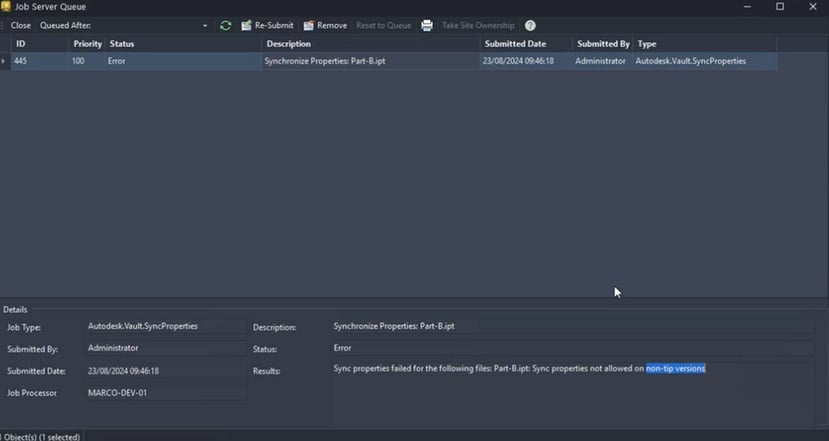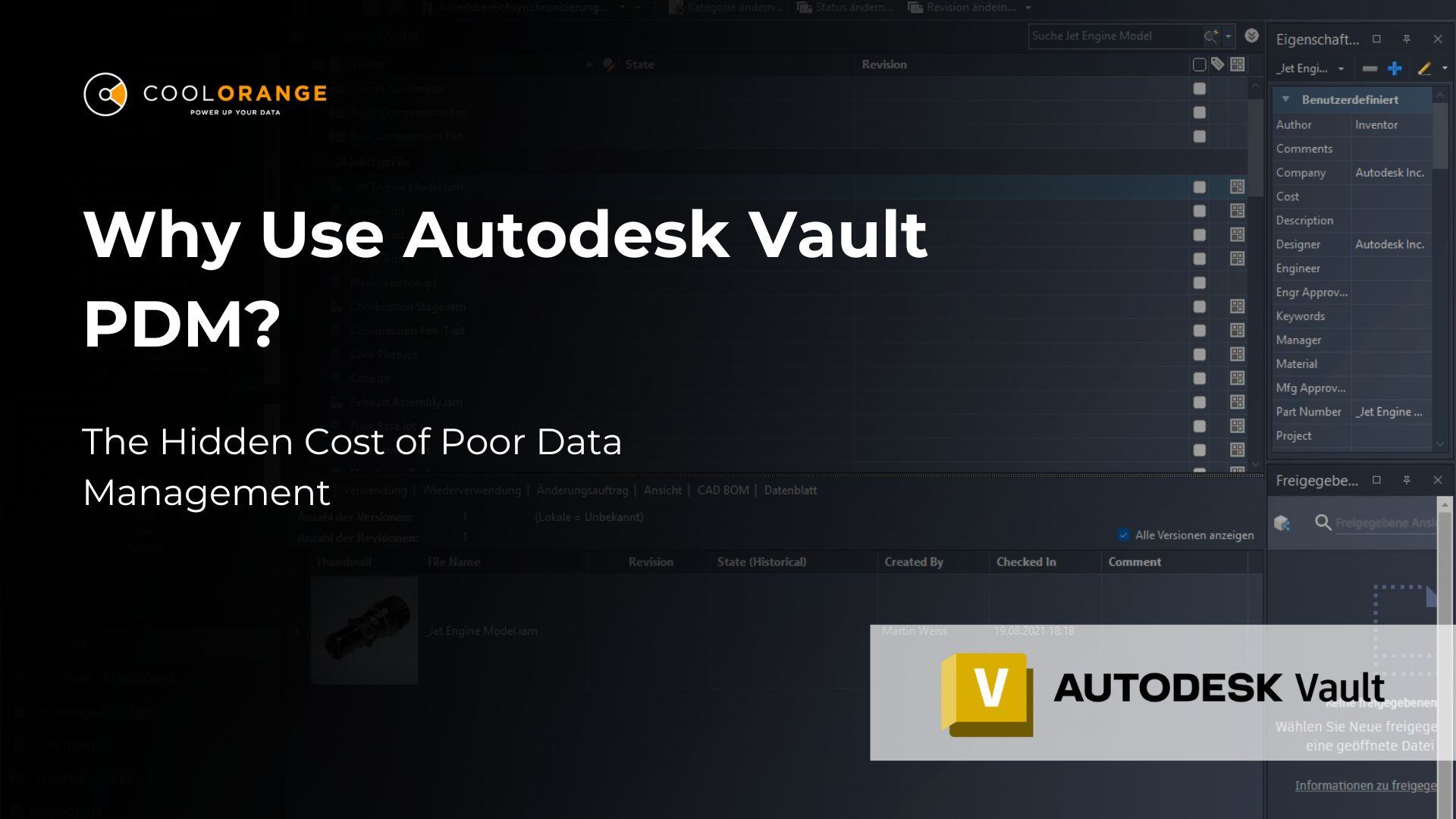Vault best practices
Non-Tip versions Synchronize Properties Error: Vault Job Queue
Consider the workflow of an engineer managing part or assembly releases through Autodesk Vault with a Flexible lifecycle configuration:
-
Initiating Release: The engineer initiates the release process for a part or assembly. Due to lifecycle transition settings, this triggers predefined standard jobs (like property synchronization) in Autodesk Vault automatically.
-
Job Processor Status: At this point, the job processor may be idle. It will remain idle until it either resumes on its own or is manually resumed, at which time it begins processing the queued jobs.
-
Handling the Queue: If the job processor were to process the job immediately, there would be no issue. However, if the queue is full, the processor might not immediately handle the job intended for release. It needs to clear other pending jobs first or wait out a predetermined idle time, say 10 minutes, before starting on new tasks.
-
Making Last Minute Changes: Suppose the engineer notices an oversight, such as a forgotten company detail in the properties, and decides to make a correction. Whether the change is minor or significant, the engineer quickly implements it - taking just about 30 seconds.
-
Releasing Again: The engineer re-releases the part or assembly before the job processor has a chance to process the earlier queued job, which is linked to a specific version of the part or assembly.
-
Potential Issue: Despite the rapid correction and re-release, an error occurs. The error message "Synchronize properties not allowed on non-tip versions" appears because the changes were made to a version of the part or assembly that was not the latest (tip) version, reflecting a synchronization issue with properties on prior versions after a new release was made.

Overview of the Error
When a design is released, the "synchronize properties" job is added to the queue. If someone then revisits the design to mark it as "work in progress" or makes a "quick change," an error message "Synchronize properties not allowed on non-tip versions" will be triggered.
This error occurs consistently whenever the version or revision of the design tied to the synchronize properties job is modified, before the job is executed.
This can be viewed as a protective feature by Autodesk to ensure data integrity.
It prevents property desynchronization by ensuring that if a design is altered after the “synchronize properties job” has been queued but before it is processed, the job does not proceed based on outdated information. This safeguard ensures that when generating PDFs, DXF, and STEP files, they reflect the correct version and revision of the design.
Impact for Administrators and on workflows
Despite the benefits of the safety feature, this can lead to several other issues or impacts beyond the increased administrative burden:
-
Workflow Disruptions: Designers and engineers may experience interruptions in their workflow when they attempt to make changes to designs that have already been queued for synchronization. The error message can halt their progress, requiring them to wait for administrative intervention or for the job queue to be cleared or corrected. This can slow down project timelines and affect productivity.
-
Increased Communication Overhead: There may be a need for increased communication between team members, particularly between designers and the IT or administrative staff managing the Autodesk software and job queues. When errors occur, resolving them can require back-and-forth discussions to identify the root cause and decide on the next steps.
The issue of synchronization errors in the job queue primarily impacts administrators by adding complexity to job queue management. Here are the key impacts:
-
Error Resolution: Each time an error occurs, it typically requires manual intervention to either clear the error from the queue or to rerun the job for the correct version of the design. This can be time-consuming and requires a detailed understanding of the jobs and the changes made to the designs.
-
Preventative Measures: Administrators might need to implement more sophisticated checks or automate aspects of error handling to prevent jobs from failing due to version conflicts. This could involve scripting or the use of third-party tools to enhance the capabilities of the job processor.
-
Training and Guidelines: Administrators may need to provide additional training for designers and engineers on the importance of managing versions and revisions correctly to minimize job queue errors. Establishing best practices and guidelines could help reduce the frequency of these errors.
-
System Configuration Adjustments: Adjusting system configurations to better handle job queue priorities and to deal with non-tip version issues more gracefully might also be necessary. This could include setting up more granular control over job execution or improving how the system handles file versioning and lifecycle states.
Synchronization errors cause workflow disruptions, increased communication, and require manual intervention, adding complexity to job queue management.
Solution – powerJobs' Pop-Up Message
powerjobs has a solution to the problem, but it is not enabled by default.
To enable it, you must navigate to a specific folder within the installation directory and transfer this folder to the working directory.
Once enabled, this feature prevents changes to the state of a design with a pending synchronized properties job. Any attempt to modify such a design will trigger a pop-up error message indicating that changes cannot be made until the job processor has completed executing the pending jobs.

This feature of powerjobs offers several advantages for managing file state changes and job processing in Vault environments. Such as:
-
Workflow Efficiency: By enforcing a pop message, until the job processor has completed its tasks, powerjobs helps maintain a smooth and efficient workflow. This reduces the likelihood of accumulation of errors un the job queue and system overloads, which can slow down overall productivity and lead to missed deadlines or project delays.
-
Administrative Control: For administrators, this solution reduces the frequency and severity of errors that need to be manually corrected. It simplifies the management of the job queue by automatically handling potential conflicts before they become problematic, which can save significant time and resources.
-
User Accountability: By clearly notifying users that they cannot proceed with changes until current jobs are processed, powerjobs reinforces the importance of following proper procedures. This can introduce a culture of accountability and meticulousness, which are vital in settings where precise documentation is critical.
-
Reduced Risk of Data Loss: Preventing premature state changes reduces the risk of data loss or corruption that can occur when multiple revisions are not properly synchronized. This safeguard is particularly important in environments where data loss can result in significant setbacks or financial loss.
-
Better Resource Allocation: Since the job processor can complete tasks without interruption, system resources are used more efficiently. This optimized resource allocation can lead to faster processing times and less downtime, enhancing overall system performance.
Here you can find a step-by-step Guide on how to activate this powerJobs Guardrail:



